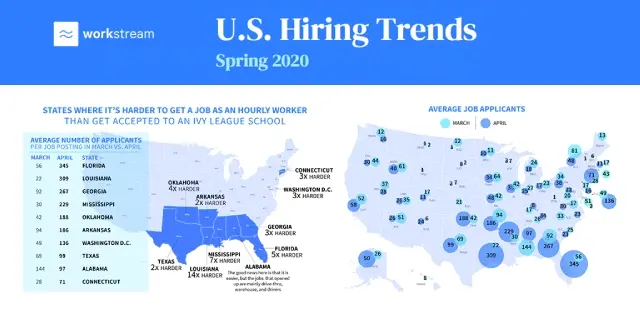“If all the economists were laid end to end, they would not reach a conclusion." - George Bernard Shaw (main attribution)
In this week’s newsletter, we examine the "positivity" of the latest jobs report (in more ways than one), the evolution of job qualifications during social distancing, and the case for hiring faster.
Next Wednesday, Workstream's Chief Hiring Expert, Blake Harber, will be walking you through how Domino's operators hire, which job boards deliver, and how they've changed their hiring and training process during COVID to ensure contactless delivery. Sign up here!
The June jobs report came too soon.
More than 4.8 million jobs were added last month, which is a new record in a year of breaking jobs records. This pushed unemployment down to 11.1%; still an incredibly high number, but hugely positive in light of the continuing pandemic and economic slowdown. Here's how that jobs spike looked in context:

Unfortunately the spike in jobs paled in comparison to the spike in COVID cases over the past couple weeks; cases that the June jobs report could not have factored in due to the timing of the research. This is why many economic experts are cautioning us to temper expectations as many states re-close bars, restaurants, and other retail stores.
Compounding the dire outlook is that the additional unemployment benefits are set to run out this month unless we see quick moves from the government, which we probably will. The pandemic aid programs have saved 51.1 million jobs -- a success despite its flaws -- so it's likely that more stimulus is coming which should continue to prop up hiring.
The Takeaway: The June jobs report may have painted a too-rosy picture of the state of jobs, but with more stimulus incoming (probably) and states opting not to completely shut down a second time, the US may not see another giant drop in employment. The virus is not yet contained, but now that a fairly successful jobs protection program has been tested, its coffers can be replenished to continue floating the economy.
A new set of pandemic-related skills and qualifications.
Workers are reinventing themselves during the COVID crisis. Be it ambition or just recognition that some jobs won't be coming back, many are acquiring new skills to position themselves for a much different jobs market when hiring resumes in earnest... or to position themselves to get hired at a pandemic-proof job right now.
Similarly, hourly workers may have to add new skill sets, and show them off on their resumes to get hired in a post-COVID job market. It's likely that tele-skills (conducting online interviews & training, online customer service, etc) as well as pandemic skills (taking customer temperatures, understanding of new safety and health measures) will be sought after when hiring retail workers.
A sobering example might be teachers. While schools are debating whether to bring students back onto campus or not for fall, and thereby sowing uncertain about rehiring teachers, virtual teaching jobs via companies like Springboard and Pathrise are in demand. The teachers that have added online learning to their skill sets are the ones who are being hired.
The Takeaway: We're living in a world where private companies are hiring epidemiologists. Jobs are changing and so are their requirements. As workers re-calibrate, hiring managers will want to update their job posts to reflect these new skills that will be important to businesses moving forward.
Here comes group interviews and 4-hour hiring.
Inc.com recently published a short piece on the changes they see to hiring, the focus being hiring quickly via a virtual and automated hiring process. A company named Teleperformance aims to hire 15,000 US customer service reps for their clients in the next 3 months:
"The company's recruiters have turned its virtual hiring process into a near science... After group phone interview, individual follow-ups, and final interviews with a potential manager-- on average-- successful candidates can receive job offers just three or four hours after their first interview."
Group interviews? That's a level of hiring-fu that we don't see very often. But conducting them virtually can make it seem less strange, especially if potential employees are becoming more accustomed to video meetings with multiple people at a time. Have you considered group interviews via video? Something to think about.
The Takeaway: This level of speed and efficiency can only come with hiring software in place to facilitate pre-screening, tracking interviews, vetting candidates, and sending out offers. It seems companies are accelerating their hiring to take advantage of the large pool of talent currently looking for work. The slower a business takes to hire, the more talent they will ultimately miss.
Need help hiring the right people? Workstream can help. Our platform gets you 4x the number of qualified applicants and reduces your time-to-hire by 70%.






